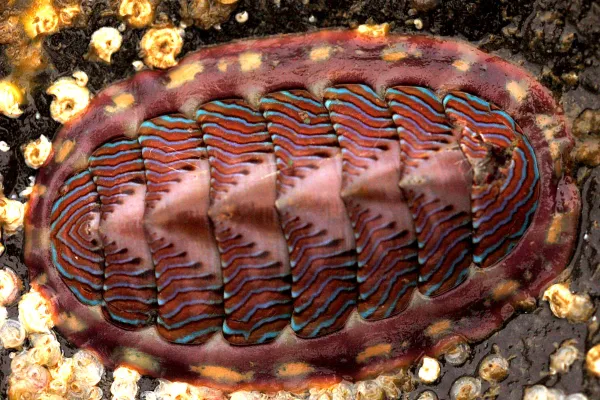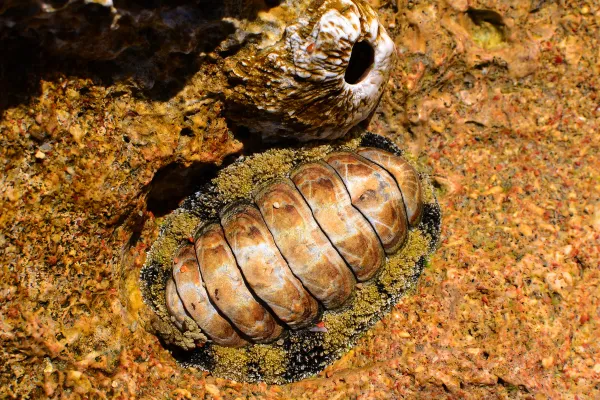Chitons are fascinating marine mollusks that belong to the class Polyplacophora. Considered among the most primitive of mollusks, they have remained largely unchanged for over 500 million years. With more than 850 recognized species, chitons are widespread but often overlooked due to their cryptic lifestyle and excellent camouflage.
In this article, we will explore what chitons are, their physical features, feeding habits, preferred habitats, and unique reproductive strategies—providing a comprehensive look at one of the ocean’s most ancient invertebrates.

Chitons are easily identified by their distinctive armor-like dorsal shell, which sets them apart from other mollusks. Here are their key features:
Eight Overlapping Shell Plates: These flexible plates cover the back of the chiton and allow it to curl into a ball for protection. The plates are layered with an inner articulating portion and a hard outer shield.
Girdle of Flesh Around the Shell: This soft structure, derived from the mantle, forms a band around the plates. It contains inhalant and exhalant grooves that move seawater over the gills—of which a single chiton can have 11 to 80 pairs.
Light-Sensitive Cells Called Aesthetes: Instead of eyes, chitons have hundreds to thousands of photoreceptive cells embedded in their shell plates that detect changes in light. These are continuously replaced due to erosion from waves and water flow.
Size: Most chitons range from 1 to 10 cm in length, though some species can grow significantly larger.
Reduced Head and Soft Underside: Their head is small and lacks sensory organs; the mouth is located at the anterior end and the anus at the rear.
No Tentacles or Appendages: They move using a strong, muscular foot located on the ventral side, which also acts like a suction cup to anchor themselves to rocky surfaces.
Gonopores and Nephridiopores: Located along the body, these structures are used for reproduction and excretion, respectively.
Advanced Muscular System: Essential for creating strong suction and allowing limited movement.
Nocturnal Behavior: Chitons are most active at night. Their slow movement, cryptic coloration, and robust armor make them difficult for predators to detect. While they have few natural enemies, chitons are consumed in some coastal regions, especially in tropical countries, as a traditional food item.
Due to their ancient body plan and unchanged morphology, chitons are often called “living fossils” of the mollusk world.
Chitons are mostly herbivorous or detritivorous, feeding on algae and biofilms that grow on rocky surfaces. Their feeding strategy includes:
Radula: A specialized tongue-like organ covered with rows of tiny, iron- and silica-hardened teeth, used to scrape algae off rocks. These structures also allow chitons to ingest microscopic organisms, such as protozoa.
Cilia and Mucus: Once food is scraped off the surface, cilia move it into the digestive tract, where it is mixed with mucus and guided into the stomach.
Carnivorous Species: Some larger chitons are capable of feeding on tiny invertebrates, such as shrimp or baby fish. These species have a more flexible mantle and smaller shell plates. They trap prey by lifting their body and snapping it shut over animals that take shelter beneath them.
To explore more, check out our articles on [Types of Algae] and [Common Marine Bacteria].

Chitons are exclusively marine creatures and are commonly found in a wide range of environments:
Coastal and Intertidal Zones: Most species live on rocks in the intertidal and subtidal zones across all oceans, from tropical reefs to cold polar waters—even Antarctica.
Deep Sea and Dark Environments: Some chitons thrive in deep ocean waters with little or no light and can withstand long periods outside water during low tide.
Substrates: They attach to natural surfaces like rocks and coral reefs, or even manmade structures such as piers, ship hulls, and breakwaters.
Homing Ability: Chitons can remember specific locations where they’ve found food. If dislodged, they often return using aesthetes (light detection), touch receptors, and chemical cues.
Chitons reproduce via external fertilization, and they are dioecious, meaning there are separate male and female individuals:
Spawning: Females release chains of eggs embedded in mucus into the water. Males simultaneously release sperm, hoping to fertilize the floating eggs.
Larval Development: The fertilized eggs hatch into trochophore larvae, which later develop into juveniles with eight shell plates and a muscular foot.
Variations in Reproduction:
Some species exhibit internal fertilization, depositing eggs afterward.
Others are ovoviviparous, retaining the eggs inside their mantle cavity until they hatch and release fully formed juveniles.
Though often overlooked, chitons play a crucial role in marine ecosystems. Their grazing helps control algal growth, and their unique physiology offers insights into early mollusk evolution. In regions where they are consumed, sustainable practices are essential to avoid overharvesting these ancient creatures.
Bibliography
Beatty, R., Beer, A., & Deeming, C. (2010). The Book of Nature. Great Britain: Dorling Kindersley.
Ibáñez, C., Sellanes, J., & Pardo-Gandarillas, M. C. (2016). Diversity of tropical polyplacophorans from the southern Panamanian Province. Latin American Journal of Aquatic Research, 44(4), 807–814.
animal tags: Chitons
We created this article in conjunction with AI technology, then made sure it was fact-checked and edited by a Animals Top editor.